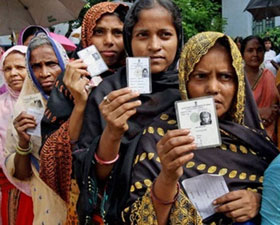 Raipur, Nov 11: Defying a boycott call of Maoists, over a third of the voters on Monday cast their ballot in the first phase of Assembly Elections in Chhattisgarh that saw a blast in Kanker and a clash in Jagdalpur.
Raipur, Nov 11: Defying a boycott call of Maoists, over a third of the voters on Monday cast their ballot in the first phase of Assembly Elections in Chhattisgarh that saw a blast in Kanker and a clash in Jagdalpur.
A CRPF jawan was killed in Naxal firing in Dantewada.
Brisk polling was reported in the early hours as several polling booths in the forested interiors were deserted bt it picked up as the day progressed. "Polling in 12 constituencies of Bastar and one in Rajnandgaon district begun from 7 am while in the rest of the seats in Rajnandgaon, it started at 8 am. So far, around 45-50% polling has been registered till 1 pm," an official with the office of Chief Electoral Officer told reporters earlier.
Briefing reporters in Delhi, Union Home Minister Sushilkumar Shinde said, "Situation in Chhattisgarh is fully under control, there are long lines since morning."
"Even in places where we had concerns, polling is taking place smoothly," he said.
Initially, majority of polling booths in jungle areas of Bastar region wore a deserted look, possibly due to Maoist diktat. However, in urban areas such as Jagdalpur town, Kanker town and in Rajnandgaon city, polling began at a routine pace and in several booths long queues were seen even before balloting started.
In Rajnandgaon seat, where BJP candidate and Chief Minister Raman Singh is contesting, women and youth were seen in large numbers lining up at polling booths.
Importantly, the 'None of The Above' (NOTA) option, widely called 'Right to Reject', is also making its debut with Chhattisgarh polls.
Meanwhile, a fierce encounter between security forces and the Naxals ended in Kanker hours after after the banned CPI-M rebels attacked a polling booth here and looted four EVM machines. There were also reports of clashes between Congress and BJP workers from Jagdalpur.
The Chhattisgarh DGP said that 15 to 20 IEDs have been found in Sukma, Kanker, Dantewada and Narayanpur.
Voting in the Naxal-infested areas will continue in these areas till 3 pm.
An Election Commission official said polling began at 8 am in the remaining booths of the six seats in Rajnandgaon district. Voters in these areas can exercise their franchise till 5 pm.
Ahead of polls, security was heightened on Sunday as two ITBP men were injured in a landmine blast.
Chief Minister Raman Singh and his three ministers in the BJP government are among 143 candidates contesting from 12 constituencies in Bastar division and six constituencies of Rajnandgaon district with an electorate of 29,33,200 in the first of the two-phase polls to the 90-member Legislative Assembly.
Singh, who is trying for a hattrick against the Congress, is contesting from Rajnandgaon where Naxals struck on poll eve. Two ITBP jawans were injured in an IED blast triggered by Naxals when a polling party was heading towards Baldongri booth.
Maoists have put up posters calling for the boycott of elections in the state. Out of the 18 seats going to polls today, BJP had won 15 while Congress had three in the last election.
Barely six months ago, Naxalites had ambushed a convoy of Congress leaders in Bastar, killing 27 people and virtually wiping out the entire party leadership, including state Congress chief Nand Kumar Patel, his son Dinesh, tribal leader Mahendra Karma who had founded the Salwa Judum and former legislator Uday Mudliyar. Senior leader Vidya Charan Shukla, 84, succumbed to his injuries two weeks later.
"Police personnel are keeping a hawk eye in the state and along its borders with Madhya Pradesh, Maharashtra, Andhra Pradesh, Odisha, Jharkhand and Uttar Pradesh," Chhattisgarh's Director General of Police (DGP) Ram Niwas told reporters hours ahead of the polling.
At least 85,000 personnel of central paramilitary forces have been deployed on poll duty in the state.
The Chief Minister's main rival is Congress' Alka Mudliyar, wife of slain Congress leader Uday Mudliyar. Raman Singh had defeated Uday Mudliyar with the margin of 32,389 votes. Devati Karma, wife of Mahendra Karma, has been fielded from Dantewada-ST seat.
The May 25 incident has been raised during campaigning in the southern part of the state, which saw high-profile visits by Sonia Gandhi, Rahul Gandhi and Narendra Modi.
Tribal welfare Minister Kedar Kashyap had won the Narayanpur segment in 2008 poll against Congress candidate Rajnuram Netam by a huge margin of 21,635 votes and this time the main opposition has fielded a low profile party worker Chandan Kashyap from this seat against him.
Sports minister Lata Usendi had previously defeated Congressman Mohan Markam from Kondagon seat in a close contest by 2771 votes. Markam has been provided a second chance from this seat.
Forest Minister Vikram Usendi has been fielded from Antagarh seat which he had won against former Congress MLA Manturam Pawar in last elections with the margin of mere 109 votes.
The sole sitting MLA of Congress in Bastar, Kawasi Lakhma has been re-nominated from Konta seat. Women voters outnumber men for first phase of polling, as 14,78,659 female voters are there against 14,53,730 men.
A total of 4,142 polling booths have been set up for this phase of which 1,517 are sensitive booths while 1,311 are hyper-sensitive stations. The rest 72 constituencies, including Bilaspur and state-capital Raipur, are scheduled for polls on November 19.
Key candidates : Raman Singh, Alka Mudliyar, Lata Usendi, Vikram Usendi, Mohan Markam, Kedar Kashyap, Devati Karma.
Important constituencies: Khairagarh, Dongargarh, Rajnandgaon, Dongargaon, Khujji, Mohla-Manpur, Antagarh, Bhanupratappur, Kanker, Keshkal, Kondagaon, Narayanpur, Bastar, Jagdalpur, Chitrakot, Dantewada, Bijapur and Konta.





Comments
Add new comment